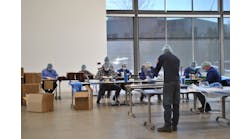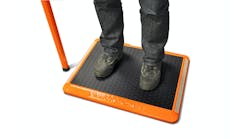I wouldn’t suggest holding an issue of Roads & Bridges over your head for protection on a jobsite. It may perform quite well in the rain, as long as the weather holds to a light mist. And until we can come up with a pure fluorescent cover it would be useless as a safety vest.
However, we do use our profits to pay for the paper, printing and postage so that the contractor, government official and consulting engineer in North America receives a monthly industry education for free. This is our duty, our obligation. If you’re not going to wear it, we would like to think Roads & Bridges is on every desk.
There is talk circulating regarding the obligation of supplying workers with their own set of personal protection equipment (PPE). In fact, the Occupational Safety and Health Administration (OSHA) has asked the industry to comment on several pivotal questions. OSHA is trying to determine if certain types of PPE should be purchased by the ones actually flirting with injury or the ones teasing budget sheets.
According to a recent survey conducted by the International Safety Equipment Association (ISEA), Arlington, Va., safety equipment use and awareness in heavy construction continues to be on the up side. Responses indicated that between 2001 and 2004, nine of 10 PPE types (hardhats, safety shoes/boots, protective eyewear, gloves, fall protection, hearing protection, respirators, protective coveralls and face shields) showed increases in the percentages of workers wearing them when needed. The survey also asked safety leaders to rate the value of PPE in minimizing the risk of accident or injury in comparison with five other protective measures—training and education, OSHA compliance, barriers and cones, signs and lights and flaggers. All six measures were thought of as highly important, but only PPE and OSHA compliance climbed in perceived importance relative to 2001 and 2002 investigations. Only one, PPE, showed an increase from 2001 to 2002 and again from 2002 to 2004.
All of the major industry associations, including ISEA, the American Road & Transportation Builders Association and the Associated General Contractors of America, have had their say with OSHA. I believe if an employer pays for the proper PPE and follows it up with the proper training it shows the worker exactly how important it is to be safe around the jobsite. The seriousness is conveyed. If a supervisor tells a crew that they’re on their own when it comes to purchasing protective eyewear or any other piece it only plants the seeds to a more casual environment.
ISEA pushes a strong point when it comes to PPE. The association says PPE is technically sophisticated, designed, built and tested to exacting standards of performance. The equipment must be properly selected and fitted, and workers must be properly trained in its use, application and maintenance. The PPE selection process demands knowledge of the workplace, understanding of the potential hazards, equipment performance and limitations, and professional skill.
The greatness of this industry lies in the fact that it’s a godsend to thousands and thousands of Americans. One could be struggling with the basic elements of survival, and then a major road construction project breaks out and offers an employment opportunity. Employers in the business know the exact definition of worker safety as it pertains to their segment of the marketplace. Sending a newcomer out to purchase his or her own pair of gloves or eyewear doesn’t make a whole lot of sense. Furthermore, an employer has access to a lot more bargains.
I would like to think the main reason PPE use is on the rise is because more and more supervisors are doing the supplying and the encouraging. The ISEA survey, however, revealed the contrary. When respondents were asked to indicate the primary reasons construction workers do not use PPE more regularly, the main reason was because “employers do not require or enforce use.” Give me a breakdown of those respondents, because I’m sure you won’t find many coming from the highway/bridge industry. However, if a worker feels safety is taken lightly, they’re free to go to the right operation.


